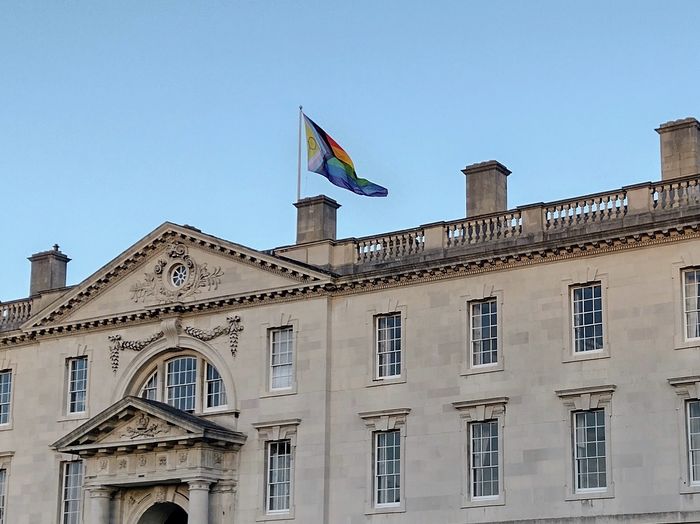20 years on, The L Word hasn’t gone out of style
At its core, the early 2000s queer drama is all about community

I’m sitting in a booth in the Iris Café with my friends. Three of us are hungover, four of us have frankly alarming workloads and all of us are queer. And, even though we have far better things to be doing, we’re drawing up a chart cataloguing every single hook-up of the last three years. It’s a near impenetrable web of relationships, situationships and that time you met your ex when she heckled your stand-up on scissoring. There are star-crossed lovers and there’s flat-cest. There are love triangles and love dodecahedrons. And, underneath lines that look like they were drawn by a spider on ketamine, sequestered beside a colour-coded key measuring the respective trauma of each relationship, are five words: “The Newnham L Word Chart”.
“Think Sex and The City with a lot more lesbians and about the same amount of biphobia”
For those who aren’t familiar (hello straights!), The L Word is a maddening drama centred on the lives of queer LA women Bette, Jenny, Tina, Shane and Alice, and the astronomical number of women they’re involved with. Think Sex and The City with a lot more lesbians and about the same amount of biphobia. Airing 2004 to 2009, the show was revolutionary in its explicit depiction of not only lesbian sex, but varied, complex lesbian relationships.

That’s not to say that sex isn’t a prominent part of the show. While many lesbian sex scenes are still weighed down by the male gaze, The L Word is a show written with queer audiences in mind. Sex scenes range from gutting (Bette and Tina’s post-cheating break-up fight) to slapstick (Dana and Alice having to hide their handcuffed wrists inside party bags for Dana’s wedding to another woman). What they share is (predominantly) the prioritisation of the relationship’s emotional basis above visual appeal. Put it this way: when Shane and Cherie get back together for the umpteenth adulterous time, you’re not thinking, that’s hot. Okay, maybe you are. But overriding that are klaxons blaring. You know they’re going to tear each other apart. The sex scene exists to draw attention to this fact. Blue is the Warmest Colour is quaking in its faux-masturbatory boots.
“The L Word reminds us that it’s fine to be our unapologetically messy, queer selves”
Beyond the sex, drugs and U-Haul, the show is a breath of feminist air. Never mind episodes, there’s hardly a conversation on The L Word that doesn’t prioritise its female – and occasional gender non-conforming – protagonists. “These women talk about everything,” says one of the show’s rare men. He’s right. These are conversations that capture the fraught, interwoven nature of queer friendships with a level of nuance that representations like Heartstopper and Love, Simon cannot grasp in their sanitised tentativeness. Point is, The L Word is like so gay now. Bonus: 20 years on, it’s still great TV.
Sure, it’s not perfect. There’s the usual early-2000s use of bisexuality as an easy punch-down. There are trans characters but you’re never quite sure if the writing is going to stick the landing. There are storylines that aren’t just cringe; they’re unwatchable. There’s Jenny. But, even after 20 years, there’s still something universal about The L Word. Maybe it’s the way everyone is a flaming pile of issues. The L Word reminds us that it’s fine to be our unapologetically messy, queer selves. It could be worse. We could be straight.
The show’s ability to hit the nail on the lesbian head (get your mind out the gutter) could have something to do with the fact that most queer women have heard of it. It’s the original “does she listen to Girl In Red?” It’s not that The L Word is a perfect encapsulation of queerness in its own right; by virtue of its release date, it’s also become a constituent of this queerness. I’m not saying you have to watch The L Word to be gay. But why not?
Back in the booth, I jolt out of this lesbian soap opera reverie and return to our “L Word Chart”, modelled off the one in the show: three years of bad decisions, tangled webs and proof that we’re all unbelievably intermeshed. I think about Alice’s words on the show: “So, the point is we’re all connected, see? Through love, through loneliness, through one tiny, lamentable lapse in judgement. All of us, in our isolation, we reach out from the darkness, from the alienation of modern life, to form these connections.” She’s pretentious but she’s right. By extension, so is The L Word. It doesn’t matter if the cast is inhumanely hot (Jennifer Beals, call me), able to afford endless artsy coffee, and not constantly mistaken for being straight while femme-presenting. I’ll even overlook the low-waisted jeans. At its core, the show is about community – queer, women, human, take your pick! – and that’s something that’s never going out of style.
 News / Clare Hall spent over £500k opposing busway 24 December 2025
News / Clare Hall spent over £500k opposing busway 24 December 2025 News / Caius mourns its tree-mendous loss23 December 2025
News / Caius mourns its tree-mendous loss23 December 2025 Comment / The ‘class’ of Cambridge24 December 2025
Comment / The ‘class’ of Cambridge24 December 2025 Comment / Yes, I’m brown – but I have more important things to say22 December 2025
Comment / Yes, I’m brown – but I have more important things to say22 December 2025 Interviews / Politics, your own way: Tilly Middlehurst on speaking out21 December 2025
Interviews / Politics, your own way: Tilly Middlehurst on speaking out21 December 2025










